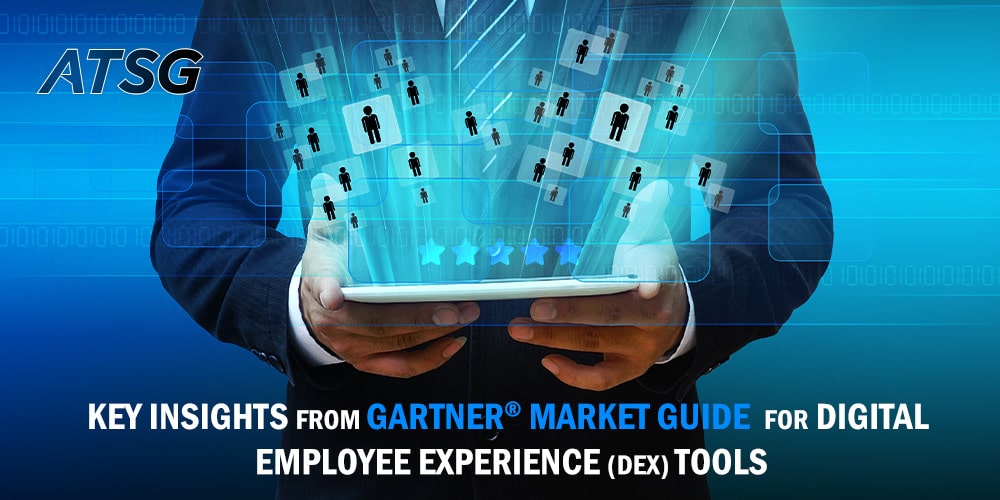Digital Employee Experience (DEX) plays an important role in organizations. With many organizations now working remotely, optimizing the DEX has become even more crucial. However, with the rise of digital workplaces, it is important to identify the right DEX tools. These tools measure and continuously improve the digital employee experience. This particularly helps infrastructure and operations (I&O) leaders understand the right tools that are required for business success.
In this article, we will cover the top trends cited in the Gartner® Market Guide for Digital Employee Experience (DEX). We will further discuss the use of DEX tools, and the benefits they provide to digital workplaces.

Key Trends Highlighted by Gartner® on DEX Tools
The market for DEX tools is growing, as both established and new vendors expand their functionality, even from adjacent markets such as endpoint management, IT service management (ITSM), and digital experience monitoring (DEM).
The need for unbiased measurement and ongoing progression of DEX is on the rise, as it has a significant impact on the overall Employee Experience (EX). This is evident from the increasing number of client inquiries and website searches, which have both been steadily increasing since January 2021.
Defining DEX Tools
Tools that fall under the category of Digital Employee Experience (DEX) are designed to monitor and enhance the performance of technology provided to employees, while also keeping track of employee sentiment. These tools process data from various sources, including endpoints, applications, and organizational context, to provide actionable insights that can drive automated self-healing processes, improve support, and increase employee engagement.
The insights gained from DEX tools can also help improve interactions with self-service portals and chatbots, and provide reliable information to teams such as IT support, asset management, and procurement. Ultimately, DEX tools can help IT leaders shift their focus from technology management, to more business-oriented tasks, while also improving the digital employee experience.
Complementary Technologies with DEX Tools
When considering options for monitoring digital experiences of employees, it may be helpful to explore digital experience monitoring (DEM) tools, which can help identify anomalies, trends, and root causes. However, it’s important to note that these tools may not be enough to address the challenges faced by I&O leaders, as they cannot generally incorporate organizational context, or engage with employees.
Alternatively, digital platform conductors (DPCs) offer the components to build a basic DEX tool, but with limited functionality and a dependence on other data sources. Human capital management (HCM) tools can capture employee sentiment, but do not provide operational data around technology performance or usage.
IT service management (ITSM) platforms offer self-service portals, chatbots, and transactional survey functionality, with some using AI to extract sentiment from text. However, sentiment alone cannot replace objective measures of DEX.
Finally, unified endpoint management (UEM) tools provide basic endpoint analytics and automation, but lack employee engagement and organizational context, and rely on manually defined workflows or triggers.
How can I&O Leaders Integrate DEX Tools?
For those who oversee the digital workplace, it’s important to ensure that the tools used to enhance the employee experience align with the organization’s strategy. It’s also a good idea to conduct a technical proof of concept (POC) to test the effectiveness of these tools.
In addition, it’s important to create a list of achievable requirements by understanding the market for these tools, the features that are typically available, and the various hosting options. Don’t get too caught up in emerging features and focus on the proven use cases. Finally, when building a business case for investing in these tools, compare the costs against the organization’s strategic objectives, with clear metrics for both objective and subjective benefits.
An Adaptive Digital Workplace
A modern digital workplace consolidates all your applications, data, documents, processes, and tasks into a single workspace. It is designed to adapt to the user’s preferences and needs, automatically displaying the most relevant information. This can include frequently used applications and information, and reminders to register hours.

An adaptive digital workplace that aligns with DEX tools like personalization, AI, and hybrid work can enhance the user experience (UX) and overall productivity. This also paves the way for successful implementation of even more digital transformation initiatives. Additionally, it can help streamline workflows by integrating different systems into a single environment, reducing repetitive tasks with automation.
The Future of DEX Tools with Outsourcing Success
Many organizations have struggled to adapt to changes in the digital workplace, and also adjusting to the tools. The adoption of DEX tools may be on the rise, but it can be challenging to integrate these across all domains of an enterprise.
By leveraging the expertise of ATSG, a global IT Solutions as a service provider, organizations can leverage a professional team to plan, implement and effectively manage an organization’s IT environment, including DEX tools.
ATSG also offers digital employee experience (DEX) services, managing the employee life-cycle processes, increasing the use of collaborative tools, enhancing security on employee devices, enabling work from anywhere (WFX), and providing multi-layered support.
By implementing a holistic digital transformation strategy, organizations can gain a competitive advantage with operational excellence. ATSG’s Digital Workplace Solutions deliver intelligent technologies and software to enhance internal and external capabilities, endorsing high standards of digital workplace maturity and productivity.
Contact ATSG for top notch Managed IT Services, Technology, Cybersecurity and Cloud Computing solutions for your enterprise.




